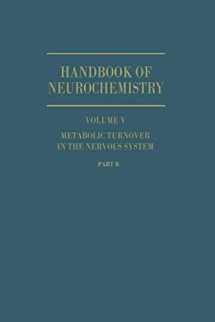
Metabolic Turnover in the Nervous System
ISBN-13:
9781461571711
ISBN-10:
1461571715
Edition:
Softcover reprint of the original 1st ed. 1971
Author:
Robert L. Herrmann, D. A. Rappoport, R. R. Fritz, S. Yamagami, A. V. Palladin, N. M. Poljakova, Isaac Schenkein, Louis Sokoloff, A. Lajtha, N. Marks
Publication date:
2013
Publisher:
Springer
Format:
Paperback
424 pages
FREE US shipping
Book details
ISBN-13:
9781461571711
ISBN-10:
1461571715
Edition:
Softcover reprint of the original 1st ed. 1971
Author:
Robert L. Herrmann, D. A. Rappoport, R. R. Fritz, S. Yamagami, A. V. Palladin, N. M. Poljakova, Isaac Schenkein, Louis Sokoloff, A. Lajtha, N. Marks
Publication date:
2013
Publisher:
Springer
Format:
Paperback
424 pages
Summary
Metabolic Turnover in the Nervous System (ISBN-13: 9781461571711 and ISBN-10: 1461571715), written by authors
Robert L. Herrmann, D. A. Rappoport, R. R. Fritz, S. Yamagami, A. V. Palladin, N. M. Poljakova, Isaac Schenkein, Louis Sokoloff, A. Lajtha, N. Marks, was published by Springer in 2013.
With an overall rating of 3.6 stars, it's a notable title among other
books. You can easily purchase or rent Metabolic Turnover in the Nervous System (Paperback) from BooksRun,
along with many other new and used
books
and textbooks.
And, if you're looking to sell your copy, our current buyback offer is $0.41.
Description
Volume V deals with the problems of turnover in the nervous system. "Turnover" is defined in different ways, and the term is used in different contexts. It is used rather broadly in the present volume, and intentionally so. The turnover of macromolecules is only one aspect; here "turnover" in dicates the simultaneous and coordinated formation and breakdown of macromolecular species. The complexities of cerebral protein turnover are shown in aseparate chapter dealing with the synthesis ofproteins, in another on breakdown, and in still another on the relationship ofthese two (showing how the two halves of turnover are controlled). The fact that most likely the two halves of protein turnover, synthesis and breakdown, are separated spatially and the mechanisms involved are different further emphasizes the complexity of macromolecular turnover. "Turnover" is used in a different context when the turnover of a cycle is discussed; but he re again a number of complex metabolic reactions have to be interrelated and controlled; some such cycles are discussed briefly in this volume, additional cycles have been discussed with metabolism, and some cycles still await elucidation or discovery.


We would LOVE it if you could help us and other readers by reviewing the book
Book review

Congratulations! We have received your book review.
{user}
{createdAt}
by {truncated_author}


